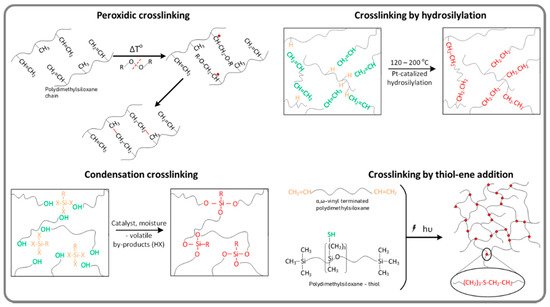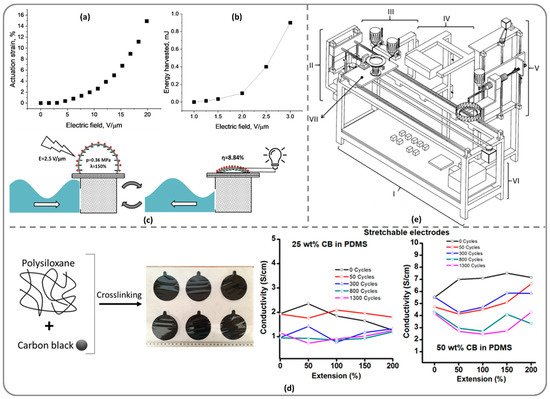Polydimethylsiloxane (PDMS) is the basis of the vast majority of silicone products that have found use in almost all areas of human activity, from cosmetics to the nuclear or aerospace industry. After 80 years from the first direct synthesis of silicones (2020), they still enjoy great interest, both scientific and applicative, being extremely versatile. Polydimethylsiloxane (PDMS), in spite of its well-defined helical structure, is an amorphous fluid even at extremely high molecular weights. The cause of this behavior is the high flexibility of the siloxane backbone and the lack of intermolecular interactions attributed to the presence of methyl groups. These make PDMS incompatible with almost any organic or inorganic component leading to phase separation in copolymers and blends. The material itself is hydrophobic and permeable to gases, with low viscosity, solubility parameters, low glass transition temperature and very low surface tension. This makes the silicones spread very easily, distinguished by their ability to form temporary films and thin coatings to more substantial durable films or with self-leveling and adhesive capacities as stand-alone sheets of different sizes and thickness, from a few micrometers to a few millimeters. One application that is based on this property is the formation of free standing, flexible submicrometric films of interest as active elements in certain devices, such as dielectric elastomer transducers (DETs). Dielectric elastomers (DEs), three-dimensional networks of long and flexible polymer chains, are soft active materials showing promising properties that mimic natural muscle for use in advanced robotics and smart prosthetics, as well as in haptic and microfluidic devices. They enjoy great interest due to their inherent flexibility, large strain, high efficiency, high energy density, and fast response of the material. In addition, some of their properties can be adjusted as required by chemical, physical or combined approaches.
- silicones
- Romania
- polymer morphology
- siloxane-organic copolymers
- highly ordered structures
- coordination polymers
1.Dielectric elastomer transducers (DETs)

2.Electromechanically Active Silicone Elastomers
| Properties | Elastomer Type | |||
|---|---|---|---|---|
| Silicone | Acrylic | Polyurethane | Natural Rubber | |
| Atmospheric ageing resistance | E | E | F | P |
| Oxidation resistance | E | E | E | G |
| Heat resistance | E | E | F–G | F–G |
| Low temperature flexibility | E | P | F | E |
| Moisture resistance | E | F | G | G–E |


This entry is adapted from the peer-reviewed paper 10.3390/polym13101605
References
- Carpi, F.; De Rossi, D.; Kornbluh, R.; Pelrine, R.E.; Sommer-Larsen, P. (Eds.) Dielectric Elastomers as Electromechanical Transducers. Fundamentals, Materials, Devices, Models and Applications of an Emerging Electroactive Polymer Technology; Elsevier Science: Amsterdam, The Netherlands, 24 March 2008.
- Shankar, R.; Ghosh, T.K.; Spontak, R.J. Electroactive Nanostructured Polymers as Tunable Actuators. Adv. Mater. 2007, 19, 2218–2223.
- Koo, C.M. Electroactive thermoplastic dielectric elastomers as a new generation polymer actuators. In Thermoplastic Elastomers; El-Sonbati, A., Ed.; InTech: London, UK, 2012; Volume 19, pp. 399–416.
- Poplavko, Y.M. Polar dielectrics in electronics. In Electronic Materials: Principles and Applied Science; Elsevier: Amsterdam, The Netherlands, 2018; pp. 509–600.
- Ni, N.; Zhang, L. Dielectric Elastomer Sensors. In Elastomers; Çankaya, N., Ed.; Chapter 11; Intechopen Publication: London, UK, 2017; pp. 231–253.
- Ignat, M.; Zarnescu, G.; Hamciuc, E.; Hamciuc, C.; Cazacu, M.; Sava, I. Microactuator Based on Polymer. Romanian Patent 127096 A2, 29 January 2016.
- Pelrine, R.; Kornbluh, R.D.; Eckerle, J.; Jeuck, P.; Oh, S.; Pei, Q.; Stanford, S. Dielectric elastomers: Generator mode fundamentals and applications. In Smart Structures and Materials 2001: Electroactive Polymer Actuators and Devices; Bar-Cohen, Y., Ed.; Society for Optics and Photonics: Bellingham, WA, USA, 2001; Volume 4329, pp. 148–156.
- Baumgartner, R.; Keplinger, C.; Kaltseis, R.; Schwödiauer, R.; Bauer, S. Dielectric elastomers: From the beginning of modern science to applications in actuators and energy harvesters. Electroactive Polymer Actuators and Devices (EAPAD) 2011. Proc. SPIE 2011, 7976, 1–6.
- Zhao, H.; Hussain, A.M.; Israr, A.; Vogt, D.M.; Duduta, M.; Clarke, D.R.; Wood, R.J. A wearable soft haptic communicator based on dielectric elastomer actuators. Soft Robot. 2020, 7, 451–461.
- Moretti, G.; Rosset, S.; Vertechy, R.; Anderson, I.; Fontana, M. A review of dielectric elastomer generator systems. Adv. Intell. Syst. 2020, 2, 2000125.
- Park, B.J.; Park, S.; Choi, M.; Park, S.K.; Yun, S.; Shin, E.; Woong, J. Monolithic focus-tunable lens technology enabled by disk-type dielectric-elastomer actuators. Sci. Rep. 2020, 10, 16937.
- Wang, J.; Gao, D.; Lee, P.S. Recent Progress in Artificial Muscles for Interactive Soft Robotics. Adv. Mater. 2021, 33, 2003088.
- Bahl, S.; Nagar, H.; Singh, I.; Sehgal, S. Smart materials types, properties and applications: A review. Mater. Today Proc. 2020, 28, 1302–1306.
- Van de Voorde, M.; de Gruyter, W. (Eds.) Nanoscience and Nanotechnology: Advances and Developments in Nano-sized Materials. GmbH & Co KG: Berlin, Germany; Boston, MA, USA, 11 June 2018.
- Zhu, F.; Zhang, C.; Qian, J.; Chen, W.Q. Mechanics of dielectric elastomers: Materials, structures, and devices. J. Zhejiang Univ. Sci. A 2016, 17, 1–21.
- Clarson, S.J.; Semlyen, J.A. Siloxane Polymers; Englewood Cliffs, N.J., Ed.; Prentice Hall: Hoboken, NJ, USA, 1993.
- Lötters, J.C.; Olthuis, W.; Veltink, P.H.; Bergveld, P. The mechanical properties of the rubber elastic polymer polydimethylsiloxane for sensor applications. J. Micromech. Microeng 1997, 7, 145–147.
- Mata, A.; Fleischman, A.J.; Roy, S. Characterization of polydimethylsiloxane (PDMS) properties for biomedical micro/nanosystems. Biomed. Microdevices 2005, 7, 281–293.
- Tugui, C.; Cazacu, M.; Sacarescu, L.; Bele, A.; Stiubianu, G.; Ursu, C.; Racles, C. Full silicone interpenetrating bi-networks with different organic groups attached to the silicon atoms. Polymer 2015, 77, 312–322.
- Bricout, N. Advantages and disadvantages of silicones. In Breast Surgery; Springer: Paris, France, 1996.
- Cichosz, S.; Masek, A.; Zaborski, M. Polymer-based sensors: A review. Polym. Test. 2018, 67, 342–348.
- Xu, F.; Li, X.; Shi, Y.; Li, L.; Wang, W.; He, L.; Liu, R. Recent developments for flexible pressure sensors: A review. Micromachines 2018, 9, 580.
- Tugui, C.; Tiron, V.; Dascalu, M.; Sacarescu, L.; Cazacu, M. From ultra-high molecular weight polydimethylsiloxane to super-soft elastomer. Eur. Polym. J. 2019, 120, 109243.
- Tugui, C.; Stiubianu, G.T.; Serbulea, M.S.; Cazacu, M. Silicone dielectric elastomers optimized by crosslinking pattern—A simple approach to high-performance actuators. Polym. Chem. 2020, 11, 3271–3284.
- Tugui, C.; Ursu, C.; Sacarescu, L.; Asandulesa, M.; Stoian, G.; Ababei, G.; Cazacu, M. Stretchable energy harvesting devices: Attempts to produce high performance electrodes. ACS Sustain. Chem. Eng. 2017, 5, 7851–7858.
- Bele, A.; Tugui, C.; Sacarescu, L.; Iacob, M.; Stiubianu, G.; Dascalu, M.; Racles, C.; Cazacu, M. Ceramic nanotubes-based elastomer composites for applications in electromechanical transducers. Mater. Des. 2018, 141, 120–131.
- Bele, A.; Tugui, C.; Asandulesa, M.; Ionita, D.; Vasiliu, L.; Stiubianu, G.; Iacob, M.; Racles, C.; Cazacu, M. Conductive stretchable composites properly engineered to develop highly compliant electrodes for dielectric elastomer actuators. Smart Mater. Struct. 2018, 27, 105005.
- Bele, A.; Cazacu, M.; Neagu, M.; Popescu, M.; Racles, C.; Ioanid, G.I. Modular Installation and Procedure for Obtaining Stratified Polymeric Generators. Romanian Patent 132642, 30 March 2020.
- Zhang, J.; Sheng, J.; ONeill, C.T.; Walsh, C.J.; Wood, R.J.; Ryu, J.H.; Desai, J.P.; Yip, M.C. Robotic Artificial Muscles: Current Progress and Future Perspectives. IEEE Trans. Robot. 2019, 35, 761–781.
- Kussmaul, B.; Risse, S.; Wegener, M.; Bluemke, M.; Krause, J.; Wagner, J.; Feller, T.; Clauberg, K.; Hitzbleck, J.; Gerhard, R.; et al. New DEA materials by organic modification of silicone and polyurethane networks. Electroact. Polym. Actuators Devices 2013, 8687.
- Biedermann, M.; Blümke, M.; Wegener, M.; Krüger, H. Improved actuation strain of PDMS-based DEA materials chemically modified with softening agents. Electroact. Polym. Actuators Devices 2015, 9430.
- Borayek, R.; Zhang, P.; Willy, H.J.; Zedan, M.; Zhu, J.; Ding, J. Programmable, UV-printable dielectric elastomers actuate at low voltage without prestretch and supporting frames. ACS Appl. Electron. Mater. 2020, 2, 4042–4053.
- Opris, D.M. Polar Elastomers as novel materials for electromechanical actuator applications. Adv. Mater. 2018, 30, 1703678.
- Racles, C.; Cazacu, M.; Fischer, B.; Opris, D.M. Synthesis and characterization of silicones containing cyanopropyl groups and their use in dielectric elastomer actuators. Smart Mater. Struct. 2013, 22, 104004.
- Racles, C.; Cozan, V.; Bele, A.; Dascalu, M. Polar silicones: Structure-dielectric properties relationship. Des. Monomers Polym. 2016, 19, 496–507.
- Racles, C.; Dascalu, M.; Bele, A.; Tiron, V.; Asandulesa, M.; Tugui, C.; Vasiliu, A.L.; Cazacu, M. All-silicone elastic composites with counter-intuitive piezoelectric response, designed for electromechanical applications. J. Mater. Chem. C 2017, 5, 6997–7010.
- Racles, C.; Bele, A.; Dascalu, M.; Musteata, V.E.; Varganici, C.D.; Ionita, D.; Vlad, S.; Cazacu, M.; Dünki, S.J.; Opris, D.M. Polar-nonpolar interconnected elastic networks with increased permittivity and high breakdown fields for dielectric elastomer transducers. RSC Adv. 2015, 5, 58428–58438.
- Racles, C.; Musteata, V.E.; Bele, A.; Dascalu, M.; Tugui, C.; Matricala, A.L. Highly stretchable composites from PDMS and polyazomethine fine particles. RSC Adv. 2015, 5, 102599–102609.
- Bele, A.; Cazacu, M.; Stiubianu, G.; Vlad, S.; Ignat, M. Polydimethylsiloxane–barium titanate composites: Preparation and evaluation of the morphology, moisture, thermal, mechanical and dielectric behavior. Compos. B Eng. 2015, 68, 237–245.
- Bele, A.; Cazacu, M.; Stiubianu, G.; Vlad, S. Silicone-barium titanate composites with increased electromechanical sensitivity. The effects of the filler morphology. RSC Adv. 2014, 4, 58522–58529.
- Bele, A.; Stiubianu, G.; Varganici, C.-D.; Ignat, M.; Cazacu, M. Silicone dielectric elastomers based on radical crosslinked high molecular weight polydimethylsiloxane co-filled with silica and barium titanate. J. Mater. Sci. 2015, 50, 6822–6832.
- Bele, A.; Dascalu, M.; Tugui, C.; Iacob, M.; Racles, C.; Sacarescu, L.; Cazacu, M. Dielectric silicone elastomers filled with in situ generated polar silsesquioxanes: Preparation, characterization and evaluation of electromechanical performance. Mater. Des. 2016, 106, 454–462.
- Ştiubianu, G.; Soroceanu, A.; Varganici, C.-D.; Tugui, C.; Cazacu, M. Dielectric elastomers based on silicones filled with transitional metal complexes. Compos. B Eng. 2016, 93, 236–243.
- Stiubianu, G.; Dumitriu, A.-M.C.; Varganici, C.-D.; Tugui, C.; Iacob, M.; Bele, A.; Cazacu, M. Changes induced in the properties of dielectric silicone elastomers by the incorporation of transition metal complexes. High Perform. Polym. 2016, 28, 915–926.
- Cazacu, M.; Racles, C.; Zaltariov, M.-F.; Dumitriu, A.-M.C.; Ignat, M.; Ovezea, D.; Stiubianu, G. Electroactive composites based on polydimethylsiloxane and some new metal complexes. Smart Mater. Struct. 2013, 22, 104008.
- Iacob, M.; Sirbu, D.; Tugui, C.; Stiubianu, G.; Sacarescu, L.; Cozan, V.; Zeleňáková, A.; Čižmár, E.; Feher, A.; Cazacu, M. Superparamagnetic amorphous iron oxide nanowires self-assembled into ordered layered structures. RSC Adv. 2015, 5, 62563–62570.
- Iacob, M.; Tugui, C.; Tiron, V.; Bele, A.; Vlad, S.; Vasiliu, T.; Cazacu, M.; Vasiliu, A.L.; Racles, C. Iron oxide nanoparticles as dielectric and piezoelectric enhancers for silicone elastomers. Smart Mater. Struct. 2017, 26, 105046.
